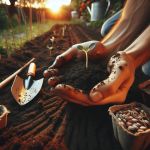This post may contain affiliate links. As an Amazon Associate, we may earn commissions from qualifying purchases.
In the fascinating world of plant propagation, air layering stands out as a highly effective technique to create new plants from your beloved ones without needing any advanced horticultural skills. “How Do I Propagate Plants Through Air Layering?” delves into the straightforward steps and tools you’ll need to successfully encourage roots to sprout from a section of a plant’s stem, while it’s still attached to the parent plant. By following this engaging guide, you’ll be on your way to expanding your green oasis with lush, thriving plants in no time! Have you ever wondered if there’s a way to multiply your favorite plants without having to go through the fuss of seeds or waiting forever for cuttings to root? Well, there is! It’s called air layering, a propagation method that allows you to clone your beloved plants quickly and efficiently. This technique isn’t just for seasoned gardeners; even if you are new to gardening, you can master air layering with a bit of guidance.
What is Air Layering?
Air layering is a propagation method that involves inducing roots to form on a branch while it’s still attached to the parent plant. This technique is a great way to create new plants while ensuring they are well-established and less likely to fail compared to other propagation methods. It’s particularly useful for plants that you can’t easily propagate through cuttings.
Why Choose Air Layering?
One of the major reasons to choose air layering is the high success rate. Because the branch or stem remains attached to the parent plant, it continues to receive water and nutrients while it develops roots. This ensures healthy and robust growth. You’ll also find that air layering works well for a variety of plants, including those that are difficult to propagate by other means.
Suitable Plants for Air Layering
Not all plants are ideal candidates for air layering, but many are. Here are some common types that respond well to this method:
| Plant Type | Examples |
|---|---|
| Trees | Figs, apples, citrus trees, magnolia |
| Shrubs | Camellia, azalea, rhododendron |
| Houseplants | Rubber plant (Ficus elastica), monstera, schefflera |
These plants are usually chosen for air layering because they have woody stems, making it easier to work with them.

Tools and Materials You’ll Need
Before diving into the process, ensure you have the following tools and materials:
- Sharp knife or pruning shears
- Sphagnum moss or other rooting medium
- Plastic wrap or a small plastic bag
- Twist ties or string
- Rooting hormone (optional)
- Plastic containers (optional for additional support)
Having everything prepared beforehand will make the process smoother and more enjoyable.
Choosing the Right Time
While you can perform air layering at various times of the year, the best time is usually in spring or early summer. The plant is actively growing during these periods, which encourages quicker root formation.
Step-by-Step Guide to Air Layering
Ready to get started? Here’s a detailed step-by-step guide to help you propagate your plants via air layering.
Step 1: Select the Branch
Choose a healthy, disease-free branch that is flexible but mature. Ideally, the branch should be about as thick as a pencil and at least a foot long. This ensures that the branch is strong enough to support new growth once separated from the parent plant.
Step 2: Make a Cut
Using a sharp knife or pruning shears, make a slanted cut about one-third to halfway through the branch. If you prefer, you can make two parallel cuts about an inch apart and remove a ring of bark between them. This technique exposes the inner wood and encourages root formation.
Step 3: Apply Rooting Hormone (Optional)
Rooting hormone can speed up the process and increase the success rate. Apply a small amount of rooting hormone to the exposed area. While this is optional, it can be particularly useful for tougher plants.
Step 4: Prepare the Rooting Medium
Soak a handful of sphagnum moss in water until fully saturated. Squeeze out the excess water so it’s damp but not dripping. Wrap the moss around the exposed area where you made the cut.
Step 5: Secure the Moss
Wrap plastic wrap or a small plastic bag around the moss to hold it in place. Use twist ties or string to secure the plastic wrap at both ends, ensuring the moss stays moist and in contact with the branch.
Step 6: Wait and Monitor
Patience is key. Over the next few weeks to months, regularly check the moss to ensure it remains moist. Within a few weeks, you should start seeing roots form within the moss. The duration may vary depending on the plant, but usually, you’ll have a good root system within a month or two.
Step 7: Remove and Plant
Once a robust network of roots has formed, it’s time to remove the new plant. Cut the branch just below the root ball and carefully remove the plastic wrap. Plant the new rooted branch into a pot filled with a quality potting mix, ensuring the roots are well-covered.

Benefits of Air Layering
Air layering offers several advantages that make it a preferred method of propagation:
- Higher Success Rate: The branch remains attached to the parent plant, minimizing the risk of failure.
- Stronger Plants: Because the new plant already has an established root system, it’s usually more robust and grows faster.
- Direct Cloning: You’ll end up with an exact genetic copy of the parent plant, ensuring consistency in features like blooms and leaf patterns.
Faster Results
Compared to seed propagation or even cuttings, air layering can produce a mature plant more quickly. This is invaluable if you are looking to expand your garden without waiting for the lengthy growth process associated with other methods.
Common Mistakes to Avoid
Even though air layering is a relatively straightforward process, there are some common pitfalls beginners might encounter. Here’s how to avoid them:
- Choosing the Wrong Branch: Always select a healthy, mature branch. Young, soft branches may not form roots as effectively.
- Inadequate Moisture: The moss must remain moist. Dry moss will not support root formation.
- Impatience: Don’t rush the process. It can take several weeks to a few months for roots to form. Constantly unwrapping the moss to check can disturb the delicate root formation process.
- Incorrect Timing: Avoid attempting air layering in the fall or winter when many plants are in a dormant state. The best time to propagate through air layering is during the active growing season.
Troubleshooting Common Issues
If you don’t see roots forming, don’t panic. Here are some troubleshooting tips:
- Check Moisture Levels: Ensure the moss is consistently moist. Adding a few drops of water if it appears dry can help.
- Temperature Concerns: Ensure the plant is kept in an environment conducive to root growth. A warm, humid climate is best.
- Using Rooting Hormone: While optional, applying rooting hormone can often expedite root growth and increase success rates, particularly with tough-to-root plants.
Aftercare for Air-Layered Plants
Once you’ve transplanted your new plant, it’s essential to provide appropriate care to ensure it thrives.
Watering
Initially, water the newly potted plant well to help the roots settle in. Keep the soil consistently moist but not waterlogged. Gradually reduce watering frequency as the plant becomes established.
Light
Place the plant in an area that receives bright, indirect light. Direct sunlight can stress the newly formed roots and cause damage.
Fertilizing
Wait at least a few weeks before fertilizing the new plant. When you’re ready, use a balanced, diluted fertilizer to support its growth. Avoid over-fertilization, as this can harm the young roots.
Air Layering vs. Other Propagation Methods
How does air layering stack up against other methods like cuttings and seed propagation? Here’s a quick comparison to help you decide.
| Method | Pros | Cons |
|---|---|---|
| Air Layering | High success rate, quicker results, stronger plants | More material required, slightly complex |
| Cuttings | Simplicity, uses fewer materials | Lower success rate, slower growth |
| Seed Propagation | Genetic diversity, can produce many plants from one parent | Slowest method, variable success rate |
Depending on your needs, you might choose one method over another. However, air layering generally offers a balanced approach with higher success rates and quicker establishment.
Getting the Most Out of Air Layering
Once you’ve mastered the basics, there are ways to optimize your technique for even better results.
Use of Hormones and Gels
While basic air layering works without additional chemicals, using rooting hormones or gels can significantly boost your success rate. These products contain growth regulators that encourage root formation and improve overall success.
Environmental Controls
Maintaining the right humidity and temperature levels can make a big difference. Using plastic wrap is already an excellent method to retain moisture, but placing the entire setup in a greenhouse or humid environment can provide added benefits.
Timing and Seasonality
While spring and early summer are ideal, air layering can be successfully performed at almost any time of the year if conditions are right. Adjust your techniques slightly depending on the season to improve your success rates.
Final Thoughts
Air layering is not just an effective propagation method but also a rewarding one. Watching a branch transform into a new plant can be incredibly satisfying. Whether you’re a beginner or an experienced gardener, mastering air layering can add another skill to your gardening toolkit.
By following the steps and tips outlined in this guide, you’ll be on your way to successfully propagating your favorite plants through air layering. Not only will you save money by not having to buy new plants, but you’ll also have the joy of sharing the beauty of your garden with friends and family through the plants you propagate yourself.
Remember, practice makes perfect. The more you practice air layering, the better you will understand the needs and nuances of your specific plants. Happy gardening!








